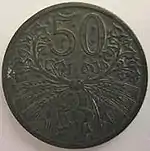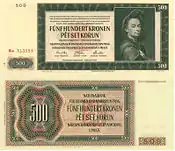Bohemian and Moravian koruna
The Bohemian and Moravian koruna, known as the Protectorate crown (Czech: Protektorátní koruna; German: Krone des Protektorats), was the currency of the Protectorate of Bohemia and Moravia between 1939 and 1945. It was subdivided into 100 haléřů.
| Bohemian and Moravian koruna | |
|---|---|
A one koruna 1939 over-stamped note | |
| Denominations | |
| Subunit | |
| 1/100 | haléř (Czech) Heller (German) |
| Plural | Kronen (German) The language(s) of this currency belong(s) to the Slavic languages. There is more than one way to construct plural forms. |
| haléř (Czech) Heller (German) | Heller (German) |
| Symbol | K |
| haléř (Czech) Heller (German) | h |
| Banknotes | 1, 5, 10, 20, 50, 100, 500, 1000, 5000 korun |
| Coins | 10, 20, 50 haléřů, 1 koruna |
| Demographics | |
| User(s) | |
This infobox shows the latest status before this currency was rendered obsolete. | |
History
The Bohemian and Moravian koruna replaced the Czechoslovak koruna at par and was replaced by the reconstituted Czechoslovak koruna, again at par. It was pegged to the Reichsmark at a rate of 1 Reichsmark = 10 koruna and was initially equal in value to the Slovak koruna, although this currency was devalued in 1940.
Coins
In 1940, zinc 10, 20 and 50 haléřů coins were introduced, followed by 1 koruna in 1941. The coins were minted until 1944.[1] The reverse designs were very similar to the earlier Czechoslovak coins. The coins were emergency issue types, similar to the coins of other German occupied territories.[2]
| Value | Mintage | Image | Notes |
|---|---|---|---|
| 10 haléřů | 82,114,000 (1940)[3][4] | .png.webp) | Mass: 1.88 Diameter: 17 Edge: Plain Composition: 100% Zinc Obverse design: Czech lion Lettering:Böhmen und Mahren ČECHY A MORAVA 1940 Reverse design: Denomination and Charles Bridge Lettering:10 |
| 20 haléřů | 106,526,000 (1940)[5] | .png.webp) | Mass: 2.63 Diameter: 20 Thickness: 1.25 Edge: Plain Composition: 100% Zinc Obverse design:Czech lion Lettering: Böhmen und Mahren ČECHY A MORAVA 1940 Reverse design: Denomination with wheat ears and sickle Lettering: 20 |
| 50 haléřů | 53,270,000 (1940)[6] |   | Mass: 3.7 Diameter: 22 Edge: Milled Composition: 100% Zinc Obverse design: Czech lion Lettering: Böhmen und Mahren ČECHY A MORAVA 1940 Reverse design: Denomination with linden branches and wheat ears below Lettering: 50 |
| 1 koruna | 102,817,000 (1941)[7] | .png.webp) | Mass: 4.5 Diameter: 23 Thickness: 2 Edge: Milled Composition: 100% zinc Obverse design: Czech lion Lettering: BÖHMEN UND MAHREN ČECHY A MORAVA Reverse design: Denomination with linden branches Lettering: 1 1941 |
Banknotes
Czechoslovak banknotes for 1 koruna and 5 korun were stamped (and later printed) with "Protektorat Böhmen und Mähren" over "Protektorát Čechy a Morava," and subsequently issued in Bohemia and Moravia beginning on February 9, 1940.[8] These were followed by regular government issues of 1, 5, 50 and 100 korun in 1940,[9] 10 korun in 1942,[10] and 20 and 50 korun in 1944.[11] Nationalbank für Böhmen und Mähren in Prag (National Bank for Bohemia and Moravia in Prague) introduced 500 and 100 korun notes in 1942, followed in 1943 by overprinted Czechoslovak 5000 korun notes. In 1944, the National Bank issued regular 5000 korun notes.[11]
| Period | Issue | Value | Date | Image | Comments |
|---|---|---|---|---|---|
| Protectorate Bohemia and Moravia[10] |
1939 Provisional Issue | 1 Koruna | ND (1939) | ND.jpg.webp) |
|
| 5 Korun | ND (1939) | ND.jpg.webp) |
Jungmann | ||
| 1940 Issue | 1 Koruna | ND (1940) | ND.jpg.webp) |
||
| 5 Korun | ND (1940) | ND.jpg.webp) |
|||
| 50 Korun | 1940 | .jpg.webp) |
|||
| 100 Korun | 1940 | .jpg.webp) |
Prague Castle & Charles Bridge | ||
| 1942–44 Issue | 10 Korun | 1942 | .jpg.webp) |
||
| 20 Korun | 1944 | .jpg.webp) |
|||
| 50 Korun | 1944 | .jpg.webp) |
|||
| National Bank for Bohemia and Moravia[11] |
1942–44 Issue | 500 Korun | 1942 |  |
Brandl |
| 1,000 Korun | 1942 | .jpg.webp) |
Parler | ||
| 5,000 Korun | 1943 | .jpg.webp) |
Overprint on a 1920 Czech note - Specimen | ||
| 5,000 Korun | 1944 |  |
St. Wenceslas |
See also
References
- Colin R. Bruce; Marian Moe (1995). Collecting world coins: a full century of circulating issues. Krause Publications. p. 2102. ISBN 978-0-87341-422-7. Retrieved 14 June 2016.
- "World War II - Occupation and emergency coinages of Europe". Numista. Numista. Retrieved 14 June 2016.
- "10 Haleru - Bohemia and Moravia - Numista". Numista. Retrieved 2013-01-17.
- George S. Cuhaj (1 July 2015). Standard Catalog of World Coins 2016: 1901-2000. "F+W Media, Inc.". p. 233. ISBN 978-1-4402-4409-4. Retrieved 14 June 2016.
- "20 Haleru - Bohemia and Moravia - Numista". Numista. Retrieved 2013-01-17.
- "50 Haleru - Bohemia and Moravia - Numista". Numista. Retrieved 2013-01-17.
- "1 Koruna - Bohemia and Moravia - Numista". Numista. Retrieved 17 January 2013.
- Linzmayer, Owen (2011). "Bohemia and Moravia". The Banknote Book. San Francisco: BanknoteNews.com. Retrieved 2011-08-21.
- Cuhaj 2010, p. 125.
- Cuhaj 2010, pp. 125–26.
- Cuhaj 2010, p. 126.
Sources
- Cuhaj, George S., ed. (2010). Standard Catalog of World Paper Money General Issues (1368-1960) (13 ed.). Krause. ISBN 978-1-4402-1293-2.CS1 maint: ref=harv (link)
- Krause, Chester L.; Clifford Mishler (1991). Standard Catalog of World Coins: 1801–1991 (18th ed.). Krause Publications. ISBN 0873411501.
- Pick, Albert (1994). Standard Catalog of World Paper Money: General Issues. Colin R. Bruce II and Neil Shafer (editors) (7th ed.). Krause Publications. ISBN 0-87341-207-9.